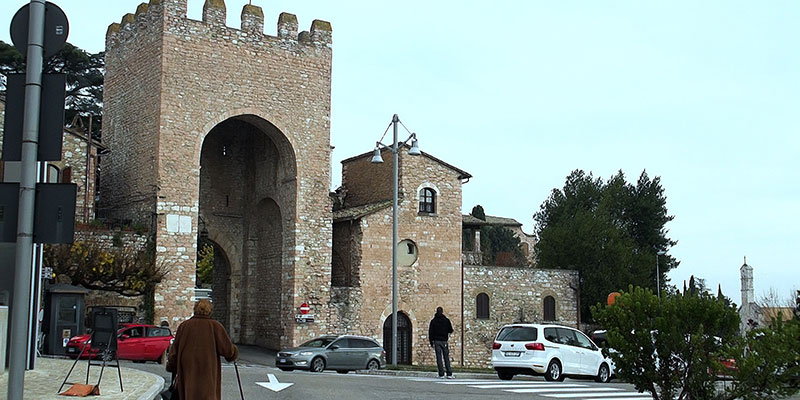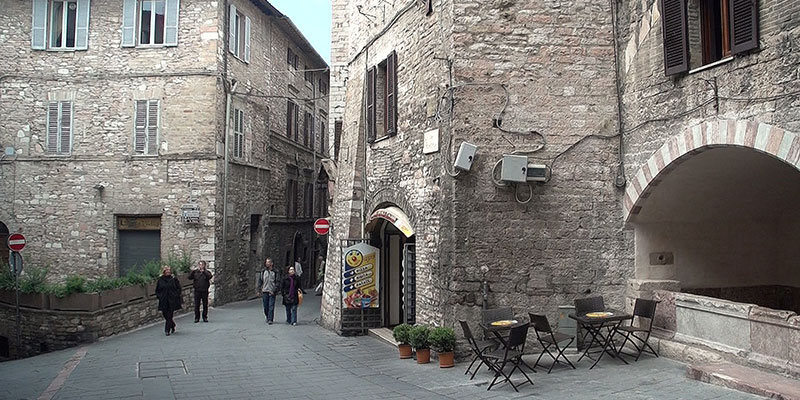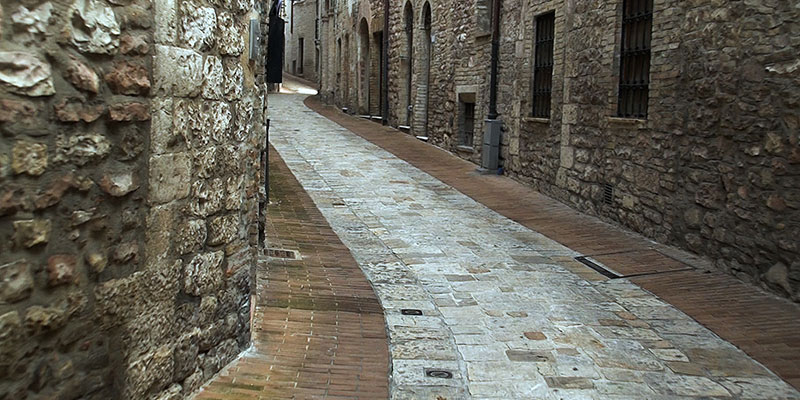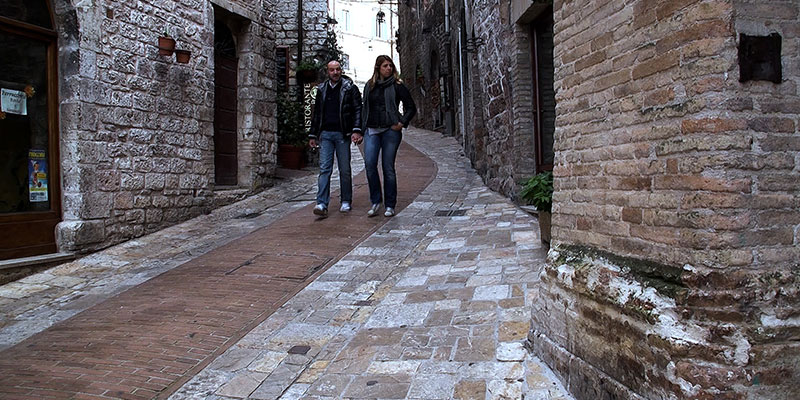The hill town of Assisi in Umbria is one of Italy's best preserved medieval villages. The ancient buildings are constructed from a local stone that has slightly pink color enhancing the visual beauty of this special place with a lovely network of pedestrian lanes to explore, some of them so steep they are staircases rather than streets.
The main reason that most people visit the town is because it was the home of Saint Francis, one of the Catholic Church's most important saints, who is buried here under the great basilica that was constructed two years after his death in the early 13th century.

Later we will visit inside the Basilica of St. Francis to enjoy its Gothic magnificence and the beauty of these early Renaissance frescoes all around us. We will show that Assisi has much more to offer the traveler because it is one of the most beautiful and best preserved of all of the Italian hill towns. Assisi is in central Italy, a 30-minute drive from Perugia and two hours from Rome or Florence. You can also get there by train or bus.

The Basilica on the west end of town is located about 400 meters from the nearest parking lot, so it's an easy walk straight over there. However, there are many other sites to see in town, as we will show you on this suggested route that takes in all those major sites, walking along those pedestrian lanes to the main piazza, as your first major destination, exploring some of the nearby lanes, then continuing to the Cathedral, called the Duomo, then up the hill to the fortress. Continue back down and around through more of those narrow lanes heading over towards the Basilica to complete your visit.

You can get started at the Porta San Pietro, which is just next to the car parking lot, and notice there are taxis out front. You could take a taxi up to the top of the hill to that fortress, and then you could walk down following our route somewhat in reverse. But walking up is also most enjoyable as you're about to find out.

Upon arrival inside the town, we came across an interesting street market. It was apparently for the locals, selling clothing, a little bit of food and produce, at very good prices from these merchants, and no souvenirs for sale here. In town you will find souvenirs and many shops selling fine handicrafts, leather goods, ceramics, and much more.

Right away, you will be impressed by the beauty of these old stone buildings, so well-preserved and taken care of. You'll quickly realize the streets are a little steeper than they look on the map. When you come to Assisi, be prepared to climb some hills and go up the staircases, and up the paths, it's steep. Typical of many Umbrian towns, it was built on a hill, partly to protect themselves from attackers, with origins of the town that go back thousands of years.
While walking along you'll be tempted to make some detours into the little side lanes, one little lane after another, so picturesque in Assisi. Every place you turn, there are picturesque sights.

In the medieval days people would build a kind of bridge over the alleyway if they wanted more room for their home, because they had no lawn in which to extend the dwelling, and there were no vacant lots inside the walls in which to build, and outside the walls, it was unsafe to live.
Some of the lanes in town are quiet residential areas with no shops, but don't worry, there are plenty of streets that are filled with stores ready to sell you fascinating items, such as along busy be via Portica, one of the main streets in town that will soon take us to the Piazza Del Comune, the thriving heartbeat of the city.

The stretch of via Portica, just west of the piazza, has one of the biggest concentrations of places to eat. Oh, it's a great spot for some quick meal, you can get sandwiches, you can get pizza, obviously, and pasta and all sorts of great local foods.

The self-service restaurant is one of those typical eateries that you're going to find all over Italy. Just stand at the counter. point you at r food, pay the lady, and find a table at the back and sit down and eat. You'll be out of there in 1/2 hour, enjoying a pretty good meal.

Which brings us to the main piazza of Assisi, Piazza del Comune – it's at the crossroads of town, you'll probably come back here several times in your visit.

There is a multilevel fountain with three lions in the southern side that dates from the 16th century. It's called the Lions Fountain, but perhaps a better name for it might be the Pigeons Fountain. At least they're trying to keep clean. There are shops and a few hotels nearby and also some major historic attractions on the piazza.

You'll get a fine seat for watching all the action from Bar Trovellesi, either at their street level portico or upstairs on the terrace – open all day for a good food, or perhaps late afternoon spritz. Café Central is another convenient spot if you just want a coffee or a light snack.

The tower is 47 meters high. It's called Torre Del Popolo, the people's tower. Palazzo Del Popolo is next to the tower, for the administrative leader of town.
The most fascinating building on the piazza is this ancient Roman temple. Its façade is intact and very well preserved with those six Corinthian columns, each one a monolithic single piece of stone, and triangular pediment. It's a bold reminder of the power and beauty of the Roman Imperial architecture. The piazza was the ancient Roman forum.

Roman invaders conquered Umbria in the year 309 BC. The Roman Empire greatly enhanced the city with new buildings and temples, and marble statues of the gods. Assisi greatly increased in prosperity during this time, with its commerce and agriculture growing rapidly.
One reason the temple survived more than 2000 years is that it has been reused in various ways, and in the Middle Ages, a church was built behind it that will surprise you with its dazzling rococo interior.

Built in the 17th century this church of Santa Maria Sopra Minerva was dedicated to St. Philip Neri, who is depicted in a fresco on the vault of the nave. During the 13th century, St. Francis preached many sermons on the steps of an earlier church here.
Back out on the piazza, there's an interesting painted arch that we learned about from a friendly local resident.
“You see an arch,” she said, “go in there and take a look. That is called the Volta Pina, the painted arch. Look carefully at it, because it's in the grotesque style, which is based on the Roman, old Roman, things that were done in the grottoes, and it is a finger in the eye of the Pope of that time. It was painted in like 1556, which was the time of the Spanish Inquisition. It was a dangerous thing to do it, put up pagan stuff. Look carefully at it – it's real obscene in places – apparently was the entrance to the bordello.

The Pope was a bad Pope, and he's the one who signed the papers that started the bonfire of the vanities, and everything. Marcelus, the governor of Assisi, had this thing commissioned, probably, and when you look at, you'll think, oh wow, how did he get away with this. He not only got away with it, but in three years they sent him to be the governor of Siena.”

You can walk out through the back of the arch, and then just south of the piazza we find another beautiful church, Chiesa Nuova, built on the site of the legendary boyhood home of St. Francis. It was here that Francis renounced his inheritance and began his divine evangelical way. Construction was financed by Philip the Third, King of Spain.



You're always going to notice these side staircases as you walk along. Maybe best to resist some of those temptations and just keep on going on the level. A lane like this is not a place for shopping or eating, or any spectacular historic sites, but these quiet neighborhoods give you a glimpse backstage into the residential life of the city.
Now you can easily return to the piazza and continue along to your next adventure that will take us along via San Ruffino, a major street leading out from the piazza to the Duomo, the San Ruffino Cathedral. Then we continue to the top of the hill visiting the Rocca fortress.

Via San Ruffino is one of the most delightful streets in town, perhaps because it connects the main piazza with the Cathedral of San Rufino, and all along the way, it's got shops and restaurants, and beautiful old buildings. Notice the paving of the street. This has been fairly consistent throughout the town. The paving is perfect. It was laid down with brick and stone in the most pleasant way, and it's so smooth and efficiently built that you will never trip or slip while walking on these beautiful lanes. It all came about after the horrific earthquake of 1997. The city was partly rebuilt, and all of these lanes were refinished with this excellent paving. There is a high-quality restaurant along San Ruffino, La Lanterna, classic Italian cuisine at a fair price with various homemade pasta dishes under €20.

It's only 200 meters from the piazza to the top of via San Ruffino where you come upon the Cathedral of San Ruffino, called the Duomo. This magnificent church is one of the most popular attractions in town. It's 12th-century Romanesque façade is considered one of the most beautiful of that period, and features three rose windows and three elegant doors - their rounded frames cut in pleasing patterns that are unusually graceful for the period. Above it all stands the Campanile tower.
The Cathedral is dedicated to St. Rufinus, the first Bishop of the city who converted to Assisi to Christianity in the year 238 and was later martyred. The interior was designed in the year 1500, with later additions in the Baroque style. St. Francis was baptized here and later preached in the church.

From the piazza in front of the church, we get the best view of the fortress up on the hill, which is our next destination, the Roca Maggiore. You'll notice there is a slight difference in altitude from the piazza up to the fortress, and there's no elevator, no escalator. We'll need a little muscle power. One of the things you want to do in Assisi is climb up to the top of the hill and get a view from the fortress, called La Rocca.

It's a bit of a steep climb. It might take you 10 to 20 minutes to get up there, but they say the view is worthwhile. So let's go find out. You could take a taxi up here, as mentioned earlier, and then walk down through all those lanes we've just seen – up to you. No matter which way, you will certainly enjoy a visit to this old fortress.
Once you're inside there is more climbing on staircases and up inside a couple of towers. They even have a snack bar where you could get some chips and a drink.

Construction of this fortress began in the year 1174, but smaller fortifications were here for many centuries earlier. After the fall of the Roman Empire in the late fifth century, Assisi was sucked into the downward spiral of the Middle Ages violence, creating a need for this powerful castle, in a commanding position on top of the hill with the strategic view looking out across the fields and hills of Umbria, and the town below.
The Holy Roman Emperor, Federico Barbarosa, use the fortress to consolidate his power against those autonomous communes that were sprouting up everywhere in central Italy.

There are several impressive large rooms inside the fortress that offer reconstructed themes that are inspired by medieval life. Walking around inside and exploring this Rocca Maggiore is just as fascinating as the views that you get looking out from it.

Be sure to head up the Maschio Tower, which leads to the highest point in the fortress, providing the most spectacular view all around, 360 degrees, including a stupendous view looking down on the Basilica of San Francesco. Later, we'll take a grand tour inside the famous Basilica, which is the main reason travelers come to Assisi.
The fortress was destroyed and rebuilt several times in its history, and then by the year 1600, it was completely abandoned, to remain almost intact as one of Italy's best preserved medieval fortresses.

Nice view looking down at the Duomo we just visited and beyond, we see the Basilica di Santa Chiara, a Gothic church dedicated to St. Clare of Assis, a devoted follower of St. Francis.

Having climbed to the top of the tower and exploring the rooms of the fortress, making your way down the narrow medieval staircase is one last adventure. The fortress is open every day from 10 AM with the last admission at 5 PM.

You can see why you need at least one full day to explore Assisi, with all of those little lanes and piazzas, and restaurants and shops, the castle, and now we're heading for the grand climax, the Basilica of St. Francis.
We've done a lot of walking up hilly streets and climbing staircases to get here, but now it's all downhill. And now we can have some pleasure of watching others climb up the steps while we go down. Some people develop clever techniques to help out, such as a lady who's pushing down on her legs as she climbs up the steps, which seems to work pretty well for her.

We've come down from the Rocca, heading now to the great Basilica of St. Francis, but first have a look at the quiet residential neighborhood along the way. It’s the kind of place they still sweep the streets by hand – maybe a few little restaurants tucked away. There's no great historic attractions along these couple of streets, but it feels authentic here. And while the main lanes are connected by some staircase streets, it's mostly a level neighborhood with straight lanes that are easy to walk.

We'll take you down to the busy shopping lane in a few minutes, which is always a popular attraction, but it's nice to get away from the crowd and enjoy some peace and serenity.
We had a chance to talk with our friendly local resident again, who keeps busy taking care of the stray cats.
"So just for wandering, is there any kind of a route?
“Ahh, just keep going. Just keep going. Just get off the main streets. All roads then lead to the Basilica of San Francesco. Okay.
"It's beautiful. It's wonderful in many ways. The thing I love about it, they cleaned it all up, and so it's a bright town. It used to be stucco, to a large extent, and they took all that down so you can see the stone again. You can see the color. So anyway, it's a beautiful place. And there are concerts, concerts, free, they are all free – medieval music, classical music. If you see a sign to San Stephano, go down and take a look at San Stephano.”

That church is tucked away on one of those tiny sidewalk side alleys that you could easily miss. This simple stone church, Chiesa di Santo Stefano, is a stark contrast to the big churches of town, and its unadorned Romanesque interior and façade show that it's one of the oldest churches in Assisi.

We have now arrived at the home stretch of the visit, approaching Via San Francesco, the main street that will take us all the way to the Basilica of that great saint. But first you will come upon Via S. Paolo, parallel to the main street and one block upslope, making it less crowded, evoking a more authentioc sense of place. Old stone buildings have been standing here for centuries, with a few modern shops sprinkled in.

Turn left to Via San Francesco, the main street of Assisi, Via San Francesco. It's the Broadway, the high street, the via Del Corso, the Champs Elysees, lined with shops, restaurants, historic sites and some hotels, and Monte Frumentario, a hospital built in 1267. Some evocative arches generate memories of earlier fortified walls around the town.

Feel free to deviate from the main lane when you see little side alleys such as up to the neighborhood of Sant Andea, or a little side stroll, and then back down to the main street.

Don't be discouraged by the cheap knickknack stores filled with miniature monks and plastic rosaries. There will be some interesting artisan shops scattered further along. This street is also a sacred route for the faithful on their pilgrimage to the divine burial place of their beloved saint.

Now we are approaching the great Basilica, framed by a long arcade. The Basilica of San Francesco ranks second only to St. Peter's in Rome as a point of Catholic pilgrimage.
Construction was started immediately after St. Francis's death in 1228 and was completed in 1253, with two churches in the same place. The lower was built first, and the upper was constructed right on top of it, each with their own architectural styles.

The life of St. Francis is illustrated in 28 frescoes by Giotto, which cover the walls of the upper church. Giotto is one of history's most important painters because he led the transition from the late medieval flat style to that of the early Renaissance with more realism, perspective and emotion.

The most famous among these many masterpieces is his Sermon to the Birds. One day while out walking with his friends, he told them, "wait for me while I go to preach to my sisters, the birds." Those birds surrounded him, intrigued by the power of his voice and not one of them flew away. He had a great love for the environment, and animals, and living a simple life in poverty. He called all living creatures his brothers and sisters.

Francesco, the hero of Assisi, is one of the most important saints of the Catholic Church. His childhood was privileged, born in the year 1181, the son of a prosperous silk merchant. Indulged by his parents, he lived a high-spirited life typical of a wealthy young man.
He joined a military expedition against Perugia and was taken prisoner for a year as a captive. Upon his return to Assisi in 1203 Francis returned to his carefree life. But then, a strange vision made him lose interest in the worldly life. He renounced his inheritance and chose poverty and simplicity.

In 1979 the church declared Francis the patron saint of ecology, declaring that Francis's love and care for creation reminded us not to behave like predators were nature is concerned, but to assume responsibility for it. In 2013, Pope Francis told journalists that he has chosen the name in honor of Francis, and had done so because he was especially concerned for the well-being of the poor.

The upper church is filled with light, illuminated by the Gothic architecture, symbolizing the saint’s celestial afterlife, whereas the more austere lower church is darker, representing the saint's life on earth - a life of sacrifice and deprivation, yet also brilliantly decorated with frescoes by Cimabue and so more by Giotto, further illustrations from the life of St. Francis.
Hundreds of books have been written about the saint, but I can only summarize in these few moments the life and deeds of the man who single-handedly revolutionized the Catholic Church through the return to values of peace and love.

He was born in 1181 at time of great inequality. There existed on the one hand, poverty and misery, and on the other selfish and debasing self-indulgence of wealth and its corresponding oppression of the poor. The church itself was a power for conquest and greed.
Francis preached brotherly love and peace to the ordinary people of Assisi. He then led his first 11 followers to Rome to seek permission from Pope Innocent the Third to found a new religious order. The Pope agreed, and even permitted him to go wherever he might deem best in the interest of his work, which led Francis to a life of wandering and preaching to spread his vision. From then on his Franciscan order grew rapidly.

On several occasions he took his message out of Italy, to Jerusalem, Spain and Egypt. Towards the end of his life, while he was praying during a 40 day fast, he had a vision during which he received the stigmata, the five wounds of Christ. He died in the year 1226 and two years later was pronounced a saint by Pope Gregory the Ninth. The next day the pope laid the foundation stone for the Basilica of St. Francis and Francis was buried there in 1230 under the lower Basilica.

Many of the sermons of St. Francis have survived and are considered some of the earliest works of literature created in the Italian language, predating Dante by 100 years.
In his final year, while quite ill, he dictated what became his most famous sermon, the “Canticle of the Sun” which I'll summarize as follows.
Be praised my Lord, through all your creatures, especially through my Lord Brother Son and Sister Moon, and the stars in heaven, Brother Wind and Air, Sister Water. Praise be you, my Lord, through Sister Mother Earth, who produces varied fruits, and flowers and herbs, which sustains and governs us.

Later on during the chaotic Middle Ages the exact location of his tomb was forgotten. But then in the following centuries it was rediscovered and remains here in its original location, underneath this altar in the lower church.
The majestic beauty and grandeur of the Basilica was created by artists and master builders who came from all over Europe to work on it.
There is no better way to know the story of Francis, than exploring his hometown. In each church you visit, each street you walk, every artwork you enjoy, you will discover a new chapter of his fascinating story.
More frescoes from the Basilica of San Francesco.
